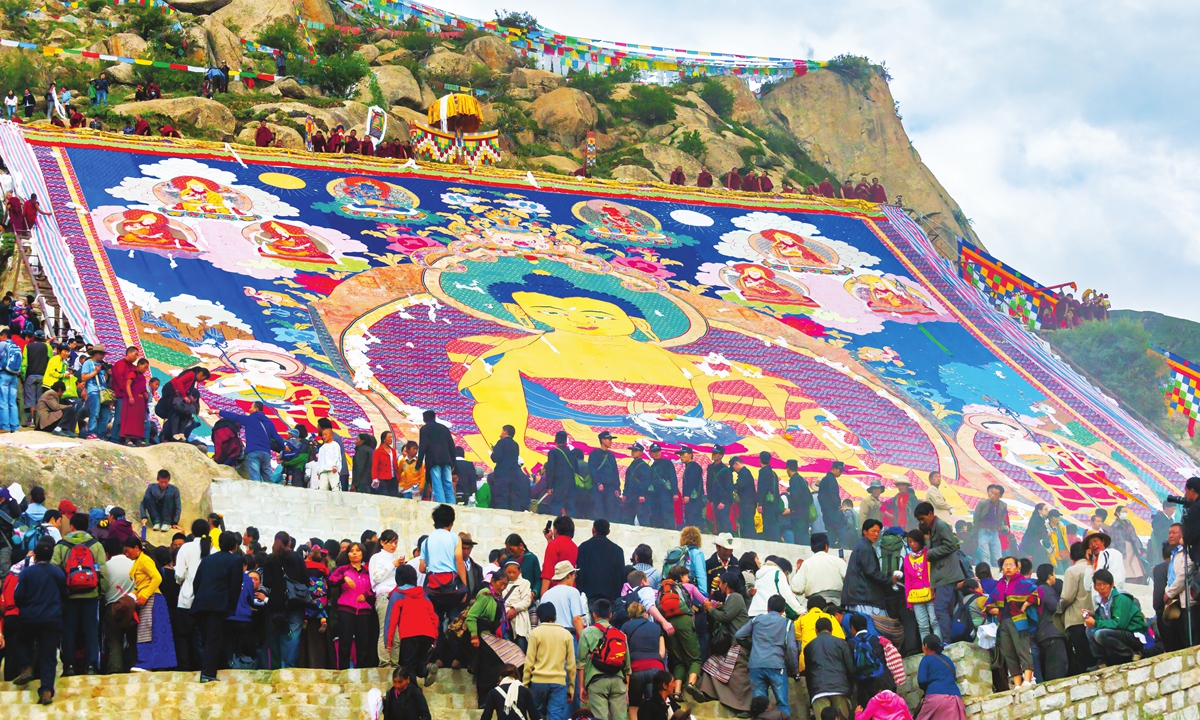The Shoton Festival (I): a symbol of distinctive Tibetan culture
The Shoton Festival is one of the most important festivals for ethnic Tibetans.
"Sho" means yogurt and "Ton" banquet in the Tibetan language, so the Shoton Festival is also called the "Yogurt Festival." The seven-day event occurs between the end of the sixth and the beginning of the seventh month of the Tibetan calendar. In 2022, it began on August 27 and will end on September 2.
Originating from the mid-11th century, the Shoton Festival used to be a religious activity. Legend goes that from the fourth to sixth month of the Tibetan calendar, Tibetan monks were forbidden to leave monasteries to prevent them from killing small creatures, which is a major taboo in the Buddhist precepts. After this 100-day meditation retreat, the ban was lifted and the monks were allowed to leave. At that time, local residents would treat them with yogurt in the suburbs and perform Tibetan operas for them. It is said that yogurt has the best taste and quality at this time of the year, so it could increase the monks' brain power. It also signifies happiness, longevity and everlasting love in Tibetan culture.
By the late 17th century and early 18th century, the theocratic system had been strengthened in Xizang as the Qing Dynasty (1644-1911) imperial government formally conferred on the fifth generation of Dalai, then leader of the Gelug Sect of Tibetan Buddhism, the title "Dalai Lama."
After 1642, the Drepung Monastery where the fifth Dalai Lama lived became the political, religious and cultural center of Xizang. Every year on the 30th day of the sixth month, thousands of people would throng into the monastery to present yogurt to the fifth Dalai Lama and asked for blessings. Local Tibetan Opera troupes would also come to perform for him at the monastery. Since then, the Shoton Festival became a religious and cultural festival.
By the period of the eighth Dalai Lama in the mid-18th century, the main venue of the Shoton Festival was moved to Norbulingka (the summer palace of the Dalai Lamas) and ordinary people were allowed to enter to watch Tibetan Opera performances. From then on, the Shoton Festival became a fixed festival.
The festival is precluded by the most prominent Giant Buddha-sunning Ceremony.
On the first day, an approximately 6- or 7-story-high Thangka painting of a Giant Buddha is displayed on the hillside at the back of the Drebung Monastery, five kilometers to the west of Lhasa. Thousands of Buddhist believers come to offer khada and pay homage to it. The ceremony lasts through the entire morning until the early afternoon.
Global Times

The Shoton Festival is one of the most important festivals for ethnic Tibetans.
"Sho" means yogurt and "Ton" banquet in the Tibetan language, so the Shoton Festival is also called the "Yogurt Festival." The seven-day event occurs between the end of the sixth and the beginning of the seventh month of the Tibetan calendar. In 2022, it began on August 27 and will end on September 2.
Originating from the mid-11th century, the Shoton Festival used to be a religious activity. Legend goes that from the fourth to sixth month of the Tibetan calendar, Tibetan monks were forbidden to leave monasteries to prevent them from killing small creatures, which is a major taboo in the Buddhist precepts. After this 100-day meditation retreat, the ban was lifted and the monks were allowed to leave. At that time, local residents would treat them with yogurt in the suburbs and perform Tibetan operas for them. It is said that yogurt has the best taste and quality at this time of the year, so it could increase the monks' brain power. It also signifies happiness, longevity and everlasting love in Tibetan culture.
By the late 17th century and early 18th century, the theocratic system had been strengthened in Xizang as the Qing Dynasty (1644-1911) imperial government formally conferred on the fifth generation of Dalai, then leader of the Gelug Sect of Tibetan Buddhism, the title "Dalai Lama."
After 1642, the Drepung Monastery where the fifth Dalai Lama lived became the political, religious and cultural center of Xizang. Every year on the 30th day of the sixth month, thousands of people would throng into the monastery to present yogurt to the fifth Dalai Lama and asked for blessings. Local Tibetan Opera troupes would also come to perform for him at the monastery. Since then, the Shoton Festival became a religious and cultural festival.
By the period of the eighth Dalai Lama in the mid-18th century, the main venue of the Shoton Festival was moved to Norbulingka (the summer palace of the Dalai Lamas) and ordinary people were allowed to enter to watch Tibetan Opera performances. From then on, the Shoton Festival became a fixed festival.
The festival is precluded by the most prominent Giant Buddha-sunning Ceremony.
On the first day, an approximately 6- or 7-story-high Thangka painting of a Giant Buddha is displayed on the hillside at the back of the Drebung Monastery, five kilometers to the west of Lhasa. Thousands of Buddhist believers come to offer khada and pay homage to it. The ceremony lasts through the entire morning until the early afternoon.
Global Times

People attend the Shoton Festival in Lhasa, Xizang Autonomous Region. Photo: IC

